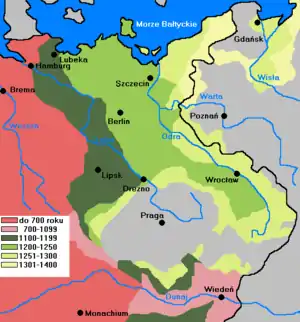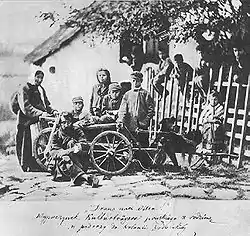Drang nach Osten
Drang nach Osten (German: [ˈdʁaŋ nax ˈʔɔstn̩]; 'Drive to the East',[1][2] or 'push eastward',[3] 'desire to push east'[4]) was the name for a 19th-century German nationalist intent to expand Germany into Slavic territories of Central and Eastern Europe.[2][5] In some historical discourse, Drang nach Osten combines historical German settlement in Central and Eastern Europe, medieval (12th to 13th century)[6] military expeditions such as those of the Teutonic Knights (the Northern Crusades), and Germanisation policies and warfare of modern German states such as those that implemented Nazism's concept of Lebensraum.[3][7]

In Polish works the term Drang nach Osten could refer to programs for the Germanization of Poland,[8] while in 19th-century Germany the slogan was used variously of a wider nationalist approbation of medieval German settlement in the east and the idea of the "superiority of German culture".[1] In the years after World War I the idea of a Drang nach Westen ('drive to the west'), an alleged Polish drive westward—an analogy of Drang nach Osten—circulated among German authors in reaction to the loss of eastern territories and the Polish Corridor.[1][9]
The concept of Drang nach Osten became a core element of Nazi ideology. In Mein Kampf (1925-1926), Adolf Hitler declares the idea to be an essential element of his reorganisation plans for Europe. He states: "It is eastwards, only and always eastwards, that the veins of our race must expand. It is the direction which nature herself has decreed for the expansion of the German peoples."[10]
Origin of the term
The first known use of Drang nach Osten was by the Polish journalist Julian Klaczko in 1849, yet it is debatable whether he invented the term as he used it in form of a citation.[11] Because the term is used almost exclusively in its German form in English, Polish, Russian, Czech and other languages, it has been concluded that the term is of German origin.[11]
Background

During the 19th and the early 20th century Drang nach Osten has been associated with the medieval German Ostsiedlung, the High Medieval migration period of ethnic Germans to Eastern Europe, inhabited by Slavs and Balts. This movement caused legal, cultural, linguistic, religious and economic changes, that had a profound influence on the history of Eastern Europe between the Baltic Sea and the Carpathians.[12]
Massive population increase during the High Middle Ages left increasing numbers of commoners like peasants, craftsmen and artisans displaced, who were joined by nobility not entitled to land inheritance, stimulating the movement of settlers from territories of the Holy Roman Empire, such as the Rhineland, Flanders and Saxony into the sparsely-populated East. These movements were supported by the Slavic kings and dukes and the Church.[13][14][15]
The future state of Prussia, named for the conquered Old Prussians, had its roots largely in these movements. As the Middle Ages came to a close, the Teutonic Knights, who had been invited to northern Poland by Konrad of Masovia, had assimilated and forcibly converted much of the southern Baltic coastlands.
After the Partitions of Poland by the Kingdom of Prussia, Austria, and the Russian Empire in the late 18th century, Prussia gained much of western Poland. The Prussians, and later the Germans, engaged in a policy of Germanization in Polish territories. Russia and Sweden eventually conquered the lands taken by the Teutonic Knights in Estonia and Livonia.
Drang nach Osten in German discourse
The term became a centerpiece of the program of the German nationalist movement in 1891, with the founding of the Alldeutschen Verbandes, in the words: "Der alte Drang nach dem Osten soll wiederbelebt werden" ('The old Drang nach Osten must be revived').[16] Nazi Germany employed the slogan in calling the Czechs a "Slav bulwark against the Drang nach Osten" in the 1938 Sudeten crisis.[2]
Despite Drang nach Osten policies, population movement took place in the opposite direction also, as people from rural, less developed areas in the East were attracted by the prospering industrial areas of Western Germany. This phenomenon became known by the German term Ostflucht, literally 'flight from the East'.
With the development of romantic nationalism in the 19th century, Polish and Russian intellectuals began referring to the German Ostsiedlung as Drang nach Osten. The German Empire and Austria-Hungary attempted to expand their power eastward; Germany by gaining influence in the declining Ottoman Empire (the Eastern Question) and Austria-Hungary through the acquisition of territory in the Balkans (such as Bosnia and Herzegovina).
Drang nach Westen
German nationalists called for a new Drang nach Osten to oppose what they conceived as a Polish Drang nach Westen ('thrust toward the West').[9]
The Polish paper Wprost used both Drang nach Osten and Drang nach Westen in August 2002 to title stories about the German company RWE taking over the Polish STOEN and Polish migration into eastern Germany, respectively.[17]
Drang nach Westen is also the ironic title of a chapter in Eric Joseph Goldberg's book Struggle for Empire, used to point out the "missing" eastward ambitions of Louis the German who instead expanded his kingdom to the West.[18]

Lebensraum concept of Nazi Germany
Adolf Hitler, dictator of Nazi Germany from 1933–1945, called for a Drang nach Osten to acquire territory for German colonists at the expense of central and eastern European nations (Lebensraum). The term, by then, had gained enough currency to appear in foreign newspapers without explanation.[19] His eastern campaigns during World War II were initially successful with the conquests of Poland, the Baltic countries, Belarus, Ukraine and much of European Russia by the Wehrmacht; Generalplan Ost was designed to eliminate the native Slavic peoples from these lands and replace them with Germans.[20] The Wehrbauer, or soldier-peasants, would settle in a fortified line to prevent civilization arising beyond and threatening Germany.[21]
This was greatly hindered by the lack of German people who desired to settle in the east, let alone act as Teutonic Knights there.[22] Settlements established during the war did not receive colonists from the Altreich, but in the main part East European Germans resettled from Soviet "spheres of interest" according to the Molotov–Ribbentrop Pact,[23] and such Poles as deemed Germanizable by Nazis.[24] However, the Soviet Union began to reverse the German conquests by 1943. Nazi Germany was defeated by the Allies in 1945.
Expulsion of Germans from the East after World War II
Most of the demographic and cultural outcome of the Ostsiedlung was terminated after World War II. The expulsion of Germans after World War II east of the Oder-Neisse line in 1945–48 on the basis of decisions of the Potsdam Conference were later justified by their beneficiaries as a rollback of the Drang nach Osten. "Historical Eastern Germany"— historically the land of the Baltic people called Old Prussians who had been colonized and assimilated by German Drang Nach Osten—was split between Poland, Russia, and Lithuania (a Baltic country) and repopulated with settlers of the respective ethnicities. The Oder-Neisse line has been accepted to be the eastern German boundary by all post-war German states (East and West Germany, as well as reunited Germany)[25], reneging on all plans to (re-)expand into or (re-)settle territories beyond this line. The Old Prussians were conquered by the Teutonic Knights in the 13th century, and gradually assimilated over the following centuries; the Old Prussian language was extinct by the 17th or early 18th century. Henry Cord Meyer, in his book "Drang nach Osten: Fortunes of a Slogan-Concept in German–Slavic Relations, 1849–1990" claims that the slogan Drang nach Osten[26] originated in the Slavic world, and it also was more widely used than in Germany.[26]
See also
References
Inline
- Ulrich Best, Transgression as a Rule: German–Polish cross-border cooperation, border discourse and EU-enlargement, 2008, p. 58, ISBN 3-8258-0654-5, ISBN 978-3-8258-0654-5
- Edmund Jan Osmańczyk, Anthony Mango, Encyclopedia of the United Nations and International Agreements, 2003, p. 579, ISBN 0-415-93921-6, ISBN 978-0-415-93921-8
- Jerzy Jan Lerski, Piotr Wróbel, Richard J. Kozicki, Historical Dictionary of Poland, 966–1945, 1996, p. 118, ISBN 0-313-26007-9, ISBN 978-0-313-26007-0
- Marcin Zaborowski, Germany, Poland and Europe, p. 32
- W. Wippermann, Der "deutsche Drang nach Osten": Ideologie und Wirklichkeit eines politischen Schlagwortes, Wissenschaftliche Buchgesellschaft, 1981, p. 87
- Drang nach Osten in the Encyclopædia Britannica
- Ingo Haar, Historiker im Nationalsozialismus, p. 17.
-
Best, Ulrich (2007). "III.2.3. The moving Other: the 'Drang nach Osten'". Transgression as a Rule: German-Polish Cross-border Cooperation, Border Discourse and EU-enlargement. Volume 3 of Forum Politische Geographie. Berlin: LIT Verlag. p. 58. ISBN 9783825806545. Retrieved 10 December 2022.
In 1896, a Polish encyclopedia defined 'Drang nach Osten': 'the drive of the Germans eastward to de-nationalise the Polish people' [...]. [...] In Poland, the slogan ties in with nationalist discourse that put the Polish nation in the role of a suffering nation, in particular at the hands of the German enemy. [...] It also responded to the situation in the Prussian-administered part of Poland, where in the later part of the 19th century Bismarck's policy of Germanisation was applied.
- Bascom Barry Hayes, Bismarck and Mitteleuropa, 1994, p. 17, ISBN 0838635121, 9780838635124
- Hitler, a chronology of his life and time. Milan Hauner, Macmillan, 1983, p. 197.
- Andreas Lawaty, Hubert Orłowski, Deutsche und Polen: Geschichte, Kultur, Politik, 2003, p. 34, ISBN 3-406-49436-6, ISBN 978-3-406-49436-9
- Katalin Szende. "Iure Theutonico ? German settlers and legal frameworks for immigration to Hungary in an East-Central European perspective". Retrieved 28 September 2020.
- Werner Rösener (1992). Agrarwirtschaft, Agrarverfassung und ländliche Gesellschaft im Mittelalter - p. 17. Oldenbourg. ISBN 978-3-486-55024-5.
- Krzysztof Brzechczyn (2009). Idealization XIII: Modeling in History. Rodopi. pp. 235–. ISBN 978-90-420-2831-9.
- Mary Fulbrook; Professor of German History Mary Fulbrook (19 February 2004). A Concise History of Germany. Cambridge University Press. pp. 13–. ISBN 978-0-521-54071-1.
- Wippermann, 1981, p. 87
- Paul Reuber, Anke Strüver, Günter Wolkersdorfer, Politische Geographien Europas - Annäherungen an ein umstrittenes Konstrukt: Annäherungen an ein umstrittenes Konstrukt, 2005, ISBN 3-8258-6523-1, ISBN 978-3-8258-6523-8
- Eric Joseph Goldberg, Struggle for Empire: Kingship and Conflict Under Louis the German, 817–876, pp. 233ff, 2006, ISBN 0-8014-3890-X, ISBN 978-0-8014-3890-5
- Carlson, p. 233.
- "Hitler's plans for Eastern Europe"
- Robert Cecil, The Myth of the Master Race: Alfred Rosenberg and Nazi Ideology p. 190 ISBN 0-396-06577-5
- Robert Cecil, The Myth of the Master Race: Alfred Rosenberg and Nazi Ideology p. 191 ISBN 0-396-06577-5
- Lynn H. Nicholas, Cruel World: The Children of Europe in the Nazi Web pp. 206–9, ISBN 0-679-77663-X
- Richard Overy, The Dictators: Hitler's Germany, Stalin's Russia, p. 543 ISBN 0-393-02030-4
- Oder–Neisse line#Schengen Agreement
- Hnet Review of Archived 27 June 2007 at the Wayback Machine Henry Cord Meyer. Drang nach Osten: Fortunes of a Slogan-Concept in German–Slavic Relations, 1849–1990. Bern: Peter Lang, 1996. 142 pp. Notes and index. $29.95 (paper), ISBN 978-3-906755-93-9. Reviewed by Douglas Selvage , Yale University.
General
- Carlson, Harold G.; John Richie Schultz (October 1937). "Loan-Words from German". American Speech. American Speech, Vol. 12, No. 3. 12 (3): 232–234. doi:10.2307/452436. JSTOR 452436.